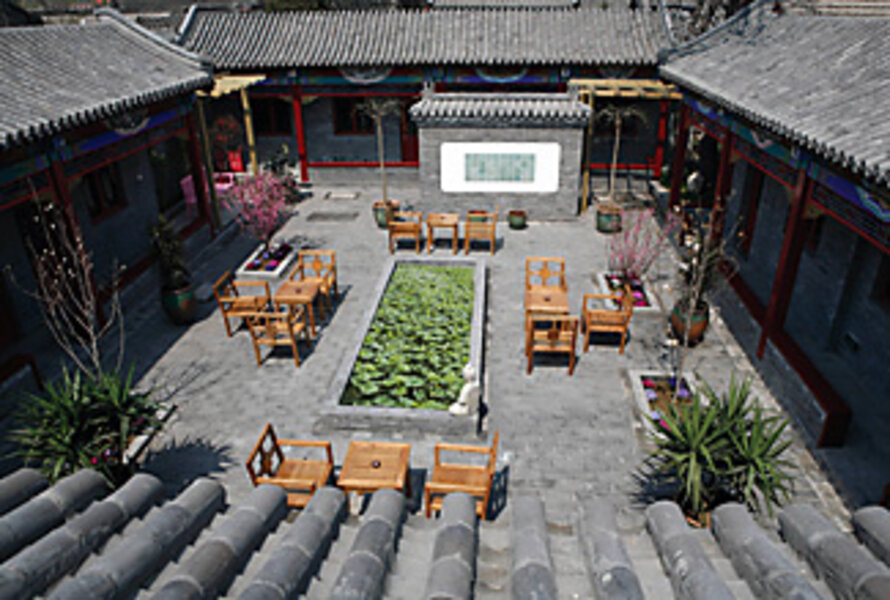Second thoughts on Beijing's new Olympic-inspired architecture
Loading...
| New Haven, Conn.
The capital hasn't seen this kind of an architectural makeover since the Mongols overtook the city, but a new Beijing may not be what's best for a modern China.
Over the summer I found myself on a dusty lot overlooking Herzog & de Meuron's newest creation: an elegant jumble of I-beams that Beijing residents wryly refer to as the "bird's nest." When it's completed, the stadium will house 90,000 spectators for the opening of the Olympics, marking what many believe to be the "Century of China." I struggled to see anything beyond the gawking tourists, imposing cranes, and cough-inducing smog.
Beijing isn't very Beijing-ish anymore. Just a decade ago, I could amble through the labyrinths of hutongs – narrow alleyways unique to the capital – and sip some cha at the neighborhood teahouse. Now I barely recognize the new Beijing.
The sleepy outpost once considered the architectural backwater of Asia now rivals Shanghai and Hong Kong as a cosmopolitan juggernaut and its ambitions do not stop there. "Beijing desperately wants to be accepted as a global city," says Jeff Soule, a consultant on China for the American Planning Association. In the last few years, Beijing has snatched the attention of the world's top architects away from the usual gang – New York, London, Paris – to power its metamorphosis at a frenetic pace that threatens to eclipse Dubai's.
It boasts the world's largest airport terminal, designed by Britain's Norman Foster (which opened last month), the immense national theater by France's Paul Andreu, and the megarestaurant LAN by Philippe Starck. But towering above anything else – both figuratively and literally – is Rem Koolhaas's 750-foot doughnut-shaped marvel for China Central Television (CCTV), which will be broadcasting this year's Olympics from the skyscraper to the 1.3 billion Chinese. "The sheer possibility of designing it, something of that magnitude and ambition, is only possible in China," says Ole Scheeren, the partner in charge of the project.
The CCTV building sits squarely in the middle of the newly established Central Business District (CBD). "Five years ago, there was nothing there besides abandoned factories," says Mr. Scheeren. He recounts being shown a blueprint of the district by government officials with 300 skyscrapers etched in – planned construction for the coming decade. Their postmodernist wonder has rewritten the playbook on space and context.
Driving toward it one day this summer, the "trouser legs" (a local nickname for the CCTV) looked imperial and gargantuan. A split moment later, as I glanced in the rear-view mirror, it seemed gaunt and teetering on collapse, like a stack of poorly placed Jenga pieces. "The role it plays is of a one-off that illustrates new possibilities," explains Scheeren. "It escapes the straitjacket of the [architectural] discipline."
Across town, and next door to the Forbidden City, developer Handel Lee is busy converting the former American Embassy – built in the dying days of the Qing Dynasty – into another international icon of Chinese extravagance, featuring chic imports like a Daniel Boulud restaurant from New York and the swanky nightclub Boujis from London. As the perfect example of Beijing's "me, too" attitude, it's telling that Mr. Lee's last project was Three on the Bund, a cultural venue that revitalized Shanghai's riverfront. And because he's gunning for the same glamorous feel, Lee has been quick to eschew provincial themes like gaudy pagoda roofs. "It's contemporary architecture," he says. "We're definitely not trying to mimic Chinese motifs."
Thankfully not everyone's quick to take the Beijing out of Beijing's architecture. Last year, Shauna Liu, born and bred in Beijing, opened Côté Cour, the first upscale hotel set in a traditional courtyard or siheyuan. Here, in one of the last cultural enclaves in the city, not much has changed since Ms. Liu's siheyuan was first built 500 years ago. Neighbors exchange gossip, kids run down the packed hutongs, and vendors hawk everyday goods like fresh fruit and pirated DVDs (OK so one thing's changed). She's managed to fuse the authentic Chinese design with a Western splash of style, bringing in Venetian plaster, glass tiles, and a lily pond. And guests couldn't be happier – she's almost booked for this year's Olympics. "You need people to experience history," Liu tells me.
Sadly, even though China's populace is no longer so complacent or disconnected, in the push to modernize, the central government has gutted Beijing's very soul.
A generation ago, some 6,000 hutongs wove through the pedestrian-friendly city. Now less than a thousand remain. More than a million local residents have been tossed into the streets, their homes commandeered in the Olympics frenzy. The whole situation ominously smacks of Mao's conquest of the capital in 1949, when he seized the siheyuans and tore down the historic city wall to make room for a humdrum slew of factories.
Millions of peasants and migrant workers are expected to pour back into Beijing after the Olympics, and the city's wealth gap continues to widen, making it hard to maintain President Hu Jintao's vision of a "harmonious society." One thing's for sure though, a doughnut-shaped icon won't be able to feed the poor.
Jerry Guo is a freelance writer. He has reported extensively throughout China.





